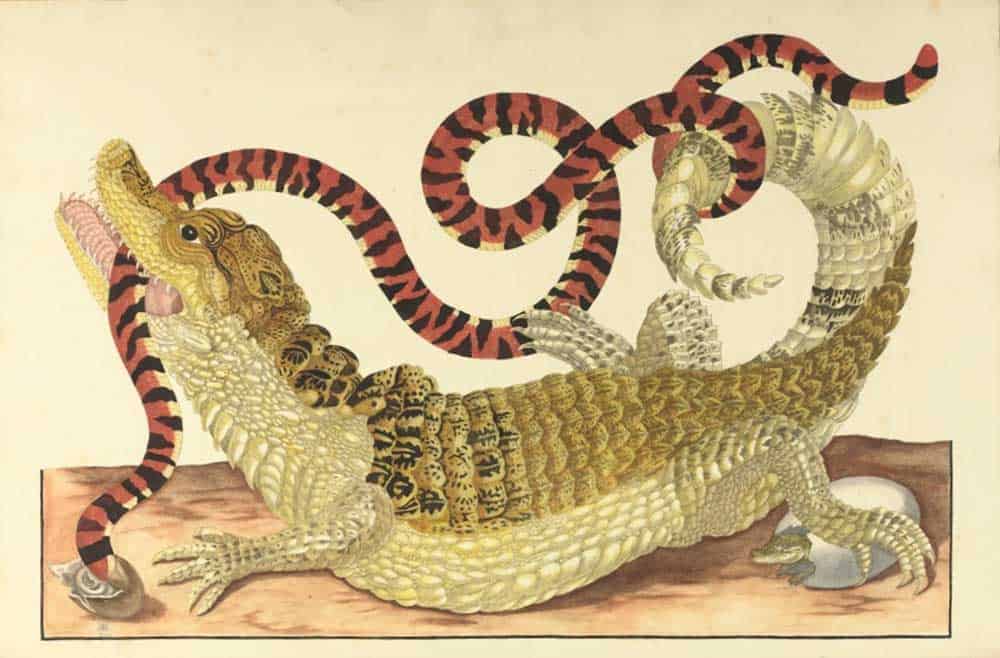DOROTHEA MARIA GRAFF (1678-1743)
The younger sister had a much more restless childhood; important years of development coincided with the family’s time in the Labadist colony where the children were separated from their parents and were educated with great strictness to become God-fearing people. She was 13-14 years old when the family moved to Amsterdam. She lived in her mother’s household and accompanied her on her great expedition to Suriname. For a long time, the dominant opinion in Merian research was that the mother had undertaken this major voyage with the older, more experienced daughter. In the surviving passenger list for the return voyage, the entry only mentions “Maria Sibilla Merian, her daughter and a native Indian woman”:
Excerpt from the Passenger List of the “De Freede” of 18 June, 1701 (1)
So a nameless daughter and a nameless native Indian woman who left no trace in the Netherlands: no official document about her release, unlike several other slaves, no entry in a death register, no grave. (2) By now Dorothea Maria’s participation in the expedition is considered to be proven after the find of a correspondence of third parties. (3)
Three weeks after their return, Phillip Hendriks’ (Hendrix), a ship’s physician from Heidelberg, published the banns for his intended marriage to Dorothea Maria in Amsterdam and they were married soon after. (4) Where did they meet? Before the voyage or on the ship? (5) Or in Suriname? (6) – Definitely not after the voyage, for then the preparation time before the wedding would have been much too short. Probably this Dr Hendriks, just like Jakob Hendrik Herolt, was an experienced advisor to his future mother-in-law even before the expedition.
The married couple lived in a house with Dorothea’s mother. But the ship’s physician was working on the East India route and was often away for more than a year. (7) He also brought back natural objects for the “firm” from his voyages. (8) Dorothea Maria became her mother’s most important collaborator (9), her “right hand”, and through the daily collaboration could develop the knowledge and craft skills she might have lacked.
Maybe later on she not only copied her mother’s motifs, but even imitated her signature; (19) for an original by Merian was, of course, more valuable to the customers than a copy fashioned by her daughter. Because the signature was used as a “brand name”, the involvement of several hands had become an important topic in research on Merian.
Ella Reitsma, through careful comparisons, discovered that works may be attributed not only to the older, but also to the younger daughter, particularly when other animals are also depicted in addition to butterflies. Thus in the Metamorphosis, there are some compositions (such as the one shown in the plate to the left) which do not correspond to Merian’s usual design layout, and where Dorothea Maria might have been involved. (11)
In the works allocated to Dorothea, the force and also the cruelty of nature in the tropics are expressed in an almost playful way. In the family firm, she was the specialist on reptiles (e.g. snakes), amphibians (kaimans) and tropical birds (e.g. ibises) which she painted with bolder brush strokes than her mother. (12)
Merian drew and painted water-colours for the eyes, the antennae and the fragile wings of insects with the finest of brush strokes and in delicate colours. Dorothea Maria’s plant motifs sometimes had a very special note when her mother added a butterfly and a caterpillar. (13)
When Merian died in early 1717, Tsar Peter the Great was just paying his second visit to Amsterdam and commissioned his personal physician and close confidant to purchase works of art for his collection in his new residence in St Petersburg. Dorothea Maria sold him a large part of her mother’s artistic estate. This physician, the highly educated Scotsman Robert Areskin (Erskine) noticed the Merian’s insect sketch book, probably insignificant to look at from the outside, and he bought it for his personal possession. (16)
In the same year, Dorothea Maria brought the family firm’s work to a successful completion by publishing another 50 plates, analogue to the first and second Caterpillar Book, containing descriptions and Dutch text, as her mother’s posthumous work. (17)
In September 1717, Dorothea Maria sold the entire stocks of the Merian publishing enterprise to an Amsterdam book seller: printed copies of the Caterpillar Books, of the Flower Book, and the Suriname Book, also illuminated copies, copperplates (some of them still from the Nuremberg times!) for further prints, but also books by other authors from the family library. This radical break with everything which had been part of her working life for decades suggests that she wanted to set off for new shores, both literally and metaphorically speaking. She signed the contract at the notary public with “Dorothea Maria Merian Weduwe (= widow) van Philip Hendrix“. (18)
For her, almost forty years old, a new life began, and she found a new life partner: the painter Georg Gsell (1673-1740) hailing from St Gallen and also a widower who had been a lodger in the Merian’s house with his daughters. (19) Gsell was called by the Tsar to his Art Academy in St Petersburg, and Dorothea Maria emigrated with him. Just like the court painter Gsell, she became a recognised teacher at the Art Academy there. As “Gsellscha” she did meritorious work for the cultural life in this new residence city. (20)
In her many years of work, together with her husband, she organised the Tsar’s collection and promoted the dissemination of her mother’s scientific and artistic heritage. (21) Today, St Petersburg has one of the world’s largest and most valuable Merian collections. But the Merian literature only rarely points out that her daughter Dorothea Maria was probably one of the most important keepers of this treasure. The Tsar even let her travel to Amsterdam again in 1734, (22) to purchase even more Merian works.
People in Nuremberg (and many international Merian researchers) should be particularly grateful to her, for without her, Merian’s insect sketch book probably would not exist any more. Who but her would have recognised the value of this unique book, and rescued it for the Tsar’s collection when Areskin died one year after his Amsterdam journey (1719)? One fact which is not often recognised in relevant publications, is that the former family garden in Nuremberg could not have been located without Merian’s personal sketch book – and apart from that a lot of interesting information about other sites of finds for her caterpillar collection would have been lost forever.





